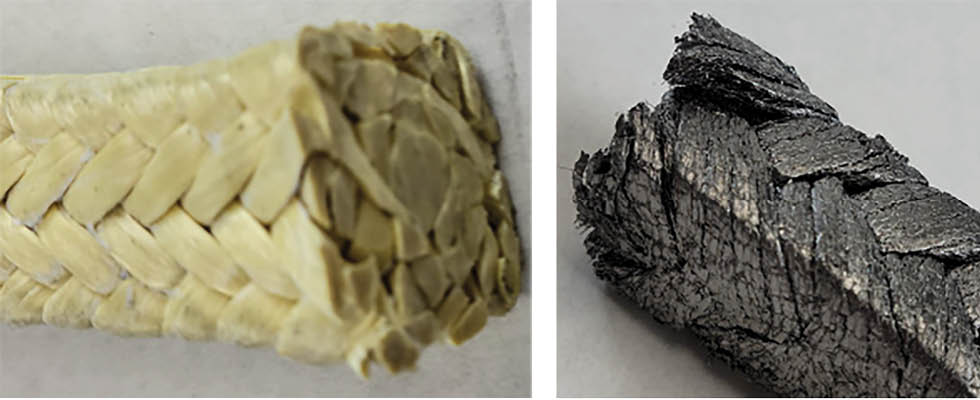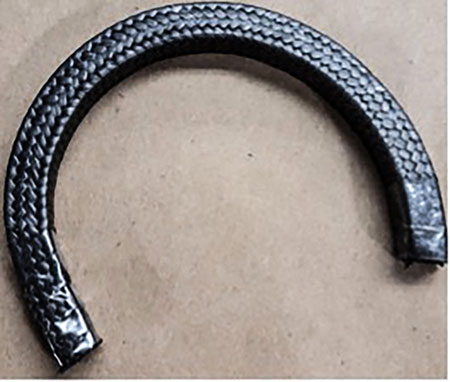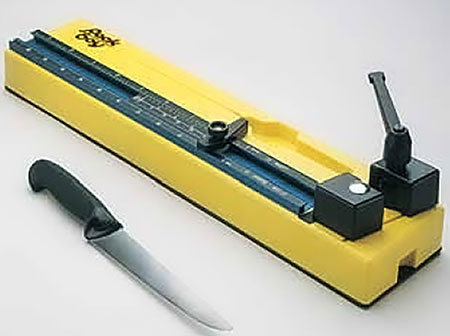
In the intricate world of mechanical packings, a persistent challenge looms large: the issue of frayed or bloomed ends. This term might not ring a bell for everyone, but it signifies a fundamental concern—the unraveling or fragmentation of packing material after it undergoes the cutting process, as illustrated in Image 1.

To tackle this frustrating problem head-on, many packing manufacturers have embraced a proactive strategy. They employ a simple yet effective solution—wrapping the braided material with tape before embarking on the precise task of cutting rings. This method is designed to ensure a clean and unblemished cut.
However, a long-standing debate has encompassed the industry regarding the utilization of braided packing rings with taped ends in various equipment applications. Over time, numerous users have grappled with a fundamental question: Should the tape on the packing ring’s ends be removed, or can it be left intact?
The Role of Taping in Ensuring Integrity
In the realm of mechanical packings, the practice of taping the ends of cut rings and lengths, as depicted in Image 2, serves several crucial purposes, all directed toward preserving the integrity and performance of these vital components.

Enhanced cross-sectional integrity
First and foremost, the application of tape plays a pivotal role in maintaining the structural integrity of the packing material. By securely binding the cross-sectional braid, it provides a stable foundation for precise cutting. This yields a cleaner and more uniform profile, facilitating the production of high-quality packing rings and lengths.
Safeguarding material during transit
Beyond manufacturing, the travel of packing rings and lengths to jobsites becomes a critical phase. During transit,
the inherent vibrations and movements within shipping packages can trigger fraying at the packing ends. Taped ends act as a safeguard, holding the material’s shape intact and preventing premature wear and tear.
Varied tape selection
Packing manufacturers exercise discretion in selecting the appropriate tape type. These tapes typically fall into a few categories: transparent poly adhesive plastic, PTFE and general-purpose
masking tape. Manufacturers often tailor their choice, favoring transparent poly adhesive tape for smaller cross-sectional packing sizes and masking-style tape for larger sizes.
Lubrication’s role
Another crucial consideration is the presence of lubricants within the braid of mechanical packings. Lubricants serve as a bonding agent, joining the strands of fibers within the packing material. While some fibers naturally interlock, others rely on these lubricants for cohesion. Certain packings are intentionally designed with minimal or no lubrication, and the absence of taping or alternative means of restraining the packing can result in immediate post-cut fraying or “blossoming.”
Mastering Clean Cuts
Achieving clean cuts and resolving frayed ends requires attention to detail:
The blade’s edge
Before starting on any cutting work, it is paramount to ensure the knife blade is honed to precision. The blade’s sharpness is the linchpin of clean and precise cuts. This becomes especially evident when multiple rings are in the crosshairs for a specific application or when the cutting transpires on a harder surface, a scenario that can quickly dull the blade. Furthermore, certain packing materials, armed with exceptionally robust fibers like aramids and carbon, possess the innate ability to expedite blade dullness. A higher density of the packing braid further compounds this challenge, impacting the blade’s longevity.
The art of resharpening
In light of these considerations, periodic resharpening of the knife blade emerges as a necessity. Regular intervals should be dedicated to the meticulous upkeep of the blade’s sharpness. This practice not only guarantees cleaner cuts but also extends the blade’s lifespan, thereby optimizing its cost-effectiveness.
Cutting tool fixtures
Beyond the blade, the utilization of cutting tool fixtures constitutes a pivotal aspect of the cutting process, as depicted in Image 3. These fixtures serve as steadfast guides, securely cradling the packing braid as the knife navigates through its intricate structure. The result is a level of consistency and repeatability in packing joints that is both reliable and commendable.
In summary, achieving clean cuts and resolving the persistent issue of frayed packing ends hinges on a blend of keen blade maintenance, resharpening practices and the strategic use of cutting tool fixtures. By embracing these principles and techniques, practitioners can elevate the quality and reliability of their mechanical packing installations.

User Expectations
When it comes to the age-old question of whether to remove the tape from the ends of packing rings, the answer hinges on a fundamental factor—user expectations. Understanding their specific concerns and priorities is important in making an informed decision about this seemingly small, yet consequential, detail.
Water usage and reduction concerns
For users committed to water usage and reduction, the consensus often leans toward removing the tape from the ends. This is because this approach typically yields the best possible performance. By eliminating any potential obstructions caused by the tape, these users can optimize packing efficiency, aligning with their water conservation goals.
Balancing act for convenience
On the flip side, not all users share the same level of concern about water usage. Some prioritize ease of installation and overall convenience. For them, the convenience of using rings with taped ends may outweigh any marginal gains in performance. Their perspective is clear: If it simplifies the installation process and does not significantly compromise performance, it is a viable choice.
The Path of Continuous Improvement
In this ever-evolving landscape of mechanical packings, one thing is certain—training and learning form a perpetual journey of improvement. Regardless of the approach chosen, it is crucial to acknowledge industry knowledge and techniques are in a constant state of refinement.
Exploring Further
To delve deeper into the realm of mechanical packings and other sealing devices, visit the Fluid Sealing Association website at fluidsealing.com. This resource offers a treasure trove of information, encompassing the latest industry news, emerging trends and standards—providing a platform for professionals dedicated to the art and science of sealing solutions.
We invite your suggestions for article topics as well as questions on sealing issues so we can better respond to the needs of the industry. Please direct your suggestions and questions to sealingsensequestions@fluidsealing.com.


